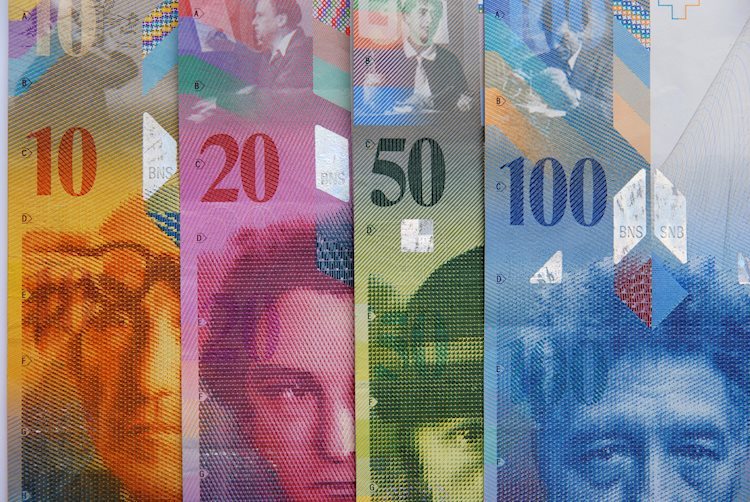- USD/CHF drops to near 0.8630 even though the US Dollar resumes its upside journey.
- The SNB is expected to cut interest rates again in December.
- Investors expect the Fed to reduce interest rates gradually.
The USD/CHF pair drops to near 0.8630 from the two-month high of 0.8370 in Monday’s North American session. The Swiss Franc pair corrects even though the US Dollar (USD) rebounds after a mild sell-off on Friday, suggesting sheer strength in the Swiss currency.
Investors have underpinned the Swiss Franc against the Greenback despite the Swiss National Bank (SNB) is expected to cut interest rates again in December. This would be the fourth straight interest rate cut in a row.
The US Dollar Index (DXY), which tracks the Greenback’s value against six major currencies, bounces back to near 103.70 and aims to extend its upside above the 11-week high around 104.00. The appeal of the Greenback has strengthened as investors expect the Federal Reserve (Fed) to cut interest rates at a moderate pace.
According to the CME FedWatch tool, the Fed is expected to cut interest rates by 25 basis points (bps) in November and December. Earlier, traders were anticipating the Fed to deliver a larger-than-usual rate cut of 50 bps in November. However, they priced out the scenario after a slew of upbeat United States (US) economic data for September.
The upside move in the USD/CHF pair appears to have paused for a while. However, the upside move could resume after it breaks above October 17 high of 0.8670. A breakout move will drive the asset toward the round-level resistance of 0.8700 and the August 15 high of 0.8750.
In an alternate scenario, a downside move below the September 12 low of 0.8550 will drag the asset toward the psychological support of 0.8500, followed by the October 2 low of 0.8450.
The near-term trend is expected to remain upbeat as the asset trades above the 20- and 50-day Exponential Moving Averages (EMAs), which trade around 0.8580.
The 14-day Relative Strength Index (RSI) oscillates near 60.00. A bullish momentum would trigger if the RSI (14) sustains above 60.00.
USD/CHF daily chart
Swiss Franc FAQs
The Swiss Franc (CHF) is Switzerland’s official currency. It is among the top ten most traded currencies globally, reaching volumes that well exceed the size of the Swiss economy. Its value is determined by the broad market sentiment, the country’s economic health or action taken by the Swiss National Bank (SNB), among other factors. Between 2011 and 2015, the Swiss Franc was pegged to the Euro (EUR). The peg was abruptly removed, resulting in a more than 20% increase in the Franc’s value, causing a turmoil in markets. Even though the peg isn’t in force anymore, CHF fortunes tend to be highly correlated with the Euro ones due to the high dependency of the Swiss economy on the neighboring Eurozone.
The Swiss Franc (CHF) is considered a safe-haven asset, or a currency that investors tend to buy in times of market stress. This is due to the perceived status of Switzerland in the world: a stable economy, a strong export sector, big central bank reserves or a longstanding political stance towards neutrality in global conflicts make the country’s currency a good choice for investors fleeing from risks. Turbulent times are likely to strengthen CHF value against other currencies that are seen as more risky to invest in.
The Swiss National Bank (SNB) meets four times a year – once every quarter, less than other major central banks – to decide on monetary policy. The bank aims for an annual inflation rate of less than 2%. When inflation is above target or forecasted to be above target in the foreseeable future, the bank will attempt to tame price growth by raising its policy rate. Higher interest rates are generally positive for the Swiss Franc (CHF) as they lead to higher yields, making the country a more attractive place for investors. On the contrary, lower interest rates tend to weaken CHF.
Macroeconomic data releases in Switzerland are key to assessing the state of the economy and can impact the Swiss Franc’s (CHF) valuation. The Swiss economy is broadly stable, but any sudden change in economic growth, inflation, current account or the central bank’s currency reserves have the potential to trigger moves in CHF. Generally, high economic growth, low unemployment and high confidence are good for CHF. Conversely, if economic data points to weakening momentum, CHF is likely to depreciate.
As a small and open economy, Switzerland is heavily dependent on the health of the neighboring Eurozone economies. The broader European Union is Switzerland’s main economic partner and a key political ally, so macroeconomic and monetary policy stability in the Eurozone is essential for Switzerland and, thus, for the Swiss Franc (CHF). With such dependency, some models suggest that the correlation between the fortunes of the Euro (EUR) and the CHF is more than 90%, or close to perfect.
Read the full article here

